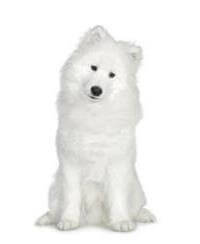Find products that match your dog’s needs

If you are looking to adopt a dog from one of the friendliest and most affectionate breeds, you should consider Samoyeds. Known for their strikingly cute smiles, Samoyed dogs are medium-sized dogs, native to Siberia. In the past, the dogs from this breed were bred for hard work such as herding and sled pulling. As a result, Samoyed breed dogs soon evolved with thick coats and fur to protect themselves from extreme cold. Consequently, they continue to thrive in cold climates and cannot withstand hot weather.
Samoyed dogs are very affectionate and love being a part of their family. They also get along well with kids and are high on playfulness. Because of their high energy levels, Samoyed puppies may find it tough to adapt to life in a city apartment. However, with the right amount of daily exercise, they will do just fine.
If you are looking to adopt a dog from this breed, you will benefit from some basic information on a Samoyed’s lifespan and physical characteristics:
Weight | 22.5 to 27 kg |
Height | 20.4 to 24 inches |
Lifespan | 12 to 14 years |
Coat | Long, straight, double coat |
Note: The weight and height mentioned on the table is of a full-grown Samoyed and not of a Samoyed puppy.
A Samoyed dog is truly a beautiful and magnificent creature to behold. This breed tends to resemble Spitz dogs, with a similarly thick furry coat that is fluffiest around the animal’s neck. A Samoyed dog’s coat will be in either of these colours:
If you are planning to bring a Samoyed home, you may wonder what a purebred Samoyed puppy looks like. Besides their beautifully fluffy coats with solid shades, here are some other features that can be seen in purebred Samoyeds:
Samoyeds are very affectionate dogs that like being in the presence of their family. They do not appreciate being left home alone and thrive in their family’s constant attention and care. They are also very loyal to their adoptive family and get along well with children. They also do well with other pets if they are taught socialisation at an early age. They do have a tendency to bark, whether at strangers who visit their home or to express their feelings. While Samoyeds can be quite mischievous, they are also very intelligent.
Yes, Samoyeds are highly intelligent dogs and are always eager to learn and train. So, they will respond well to training sessions. However, they also tend to be stubborn, so ensure that you are patient during the training sessions. Plus, it always helps to use reward-based training with dog treats that is accompanied by a positive tone. It is also advisable to teach your Samoyed puppy lessons on socialisation at an early age.
Here are a few essential pointers to keep in mind when taking care of a Samoyed dog.
While Samoyeds are known to be fairly healthy dogs, it is recommended that you take them for regular check-ups. Whether you are adopting a Samoyed puppy or an adult dog, ensure that you get them tested for knee and hip dysplasia and cardiac disorders. You would also have to get regular eye check-ups done to test for conditions like glaucoma.
Samoyeds have a beautiful white coat, which has two layers. The outer layer is a silver-tipped coat of long and straight hair and a bit harsh to touch. The undercoat, which is dense and woolly, gets shed once or twice a year. This makes grooming Samoyeds rather difficult yet important.
As mentioned earlier, Samoyeds have very high energy levels and playful tendencies. So, you would need to take them for walks on a regular basis. However, do ensure that you have your pet on a leash during walks as they have the tendency of running away in their playfulness.
Your Samoyed needs to be fed a sufficient amount of proteins, healthy fats, vitamins, and minerals. So, ensure to choose the right dog food with the necessary nutrients. You can also feed them dog treats when they fair well at training sessions. Just make sure that you do not overfeed your pet with treats as this can interfere with their main meals.
With its origin in Siberia, the Samoyed dog breed played a major role in Polar expeditions of early 1900s. The dogs were used to pull sleds in the Arctic and Antarctic regions during these expeditions. Only a few of these brave canines, who served man in his search for the Poles, returned from the harsh sufferings they had to undergo. When in Siberia, these dogs were used for hunting, herding, and sled pulling by a tribe who were also known as the Samoyeds. It is believed that the people of this tribe were nomads who showed a lot of love and affection towards their dogs. It is because of this nature of the tribe that the Samoyed dog breed learned to be affectionate towards their adoptive humans.
Discover the unique characteristics of different dog breeds on our breeds category page and find the ideal furry friend for yourself.
Samoyeds get along really well with other pets, provided they are taught to socialise well at an early age.
Samoyeds are the perfect family dogs. They are highly affectionate and friendly and love being a part of a family. They also love getting attention from all their family members and always prefer being with them.
Samoyeds do not like being home alone. At a stretch, you can leave a Samoyed home alone for a maximum of four to six hours. Any longer than that could have a negative impact on the dog.
Samoyeds do not like being home alone. At a stretch, you can leave a Samoyed home alone for a maximum of four to six hours. Any longer than that could have a negative impact on the dog.
Samoyeds are extremely vocal and use barking and howling to express their preferences. They also have a tendency to bark at strangers and visitors.

Find a PEDIGREE® stockist
near you!
Buy online
Click to buy from any of the retailers below

